November 2022
Real earnings continue to fall due to high inflation
The latest data show average regular earnings grew by 5.7% in the year to September 2022, though bonuses for some pushed headline earnings growth up by 6.0%. However, inflation is higher, at 10.1% in the year to September 2022. This means real regular earnings fell by 2.7% in the year to September 2022 (with real total earnings falling by 2.6%). The outlook for earnings remains challenging, with inflation likely to remain relatively high in the short-term. Public sector earnings grew at 2.4% in the last year, compared to 6.8% in the private sector. This is likely to add to recruitment and retention challenges for public services.
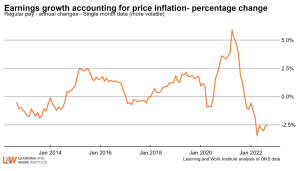
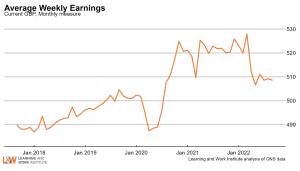
Employment has fallen and remains 334,000 below pre-pandemic levels
Employment fell by 52,000 in July to September 2022 compared to the previous quarter and remains 334,000 lower than before the pandemic. Unemployment decreased by 69,000 in July to September 2022 compared to the previous quarter. However, the falls in unemployment are driven by rises in economic inactivity (people leaving the labour force) rather than rises in employment.
Economic inactivity increased by 108,000 compared to the previous quarter and is 629,000 higher than pre-pandemic. Nearly 9 million people aged 16-64 are economically inactive, 2.7 million of whom say this is due to sickness or disability, 20% higher than pre-pandemic.
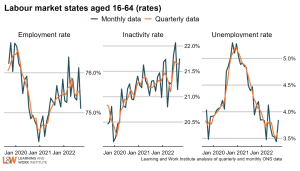
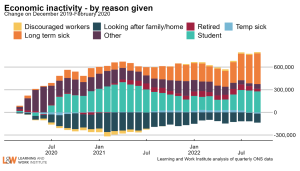
There are fewer potential workers for employers to recruit, with 681,000 fewer over 50s in the labour market since the pandemic started
Vacancies are at near record levels, but despite record hiring employers are struggling to meet all their needs. Recruitment is more challenging for employers because of rises in economic inactivity – people leaving the labour market. This has been primarily driven by those aged 50 and over and people with long-term health problems and disabilities. The number of people aged 50 and over who are economically inactive has increased by almost 5% since the pandemic started. This is a key challenge – for the Government to support people in this group who want to work and for employers to think about recruitment and job design that will meet their needs.
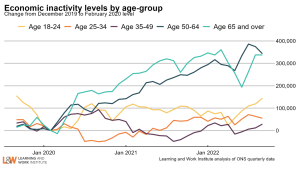
Quarterly data for employment across ethnic groups, disability status, and net labour market flows shows a stunted recovery since the pandemic
The latest disability employment data shows a risk of progress made since the pandemic being reversed. During the pandemic, the unemployment rate for those aged 16-64 with disabilities increased to 8.5%, but rapidly declined over 2021. However, it has now increased for two quarters in a row, from 6.6% the first quarter of 2022 to 7.2% in the third quarter.
The latest employment data for different ethnic groups shows that employment rates for Pakistani and Bangladeshi people have decreased over the last quarter and are now below 60% – substantially less than the national average of 75%. For Chinese people, employment rates have decreased for three quarters in a row. Employment rates increased for all other ethnic groups in the most recent quarter, indicating that racial inequalities may be hampering the post pandemic recovery.
The latest quarterly data on labour market flows shows that net employment inflows have remained positive for seven quarters in a row, however data for the third quarter of 2022 shows that net inflows are approximately twice as small as they were in the first quarter of 2022, and approximately three times smaller than they were one year ago.
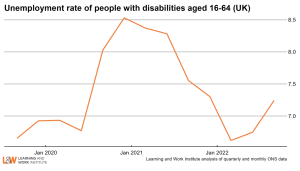

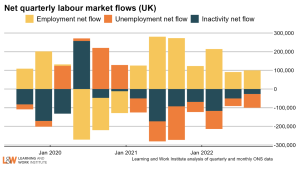
The employment picture varies across the country
Employment rates are higher than pre-pandemic 2019 levels in the North East, Yorkshire & the Humber, Eastern England, London, and Scotland, but are lower everywhere else. The economic inactivity rate is highest in Northern Ireland, Wales and the North East, however four regions have a lower economic inactivity rate now compared to 2019 – Yorkshire & the Humber, Eastern England, London, and Scotland. Yorkshire & the Humber, the West Midlands, and Northern Ireland have a higher unemployment rate now than compared to 2019. This varying picture, which is even greater at sub-regional level, shows the importance of tackling inequalities so everyone has a fair chance in life wherever they live.


